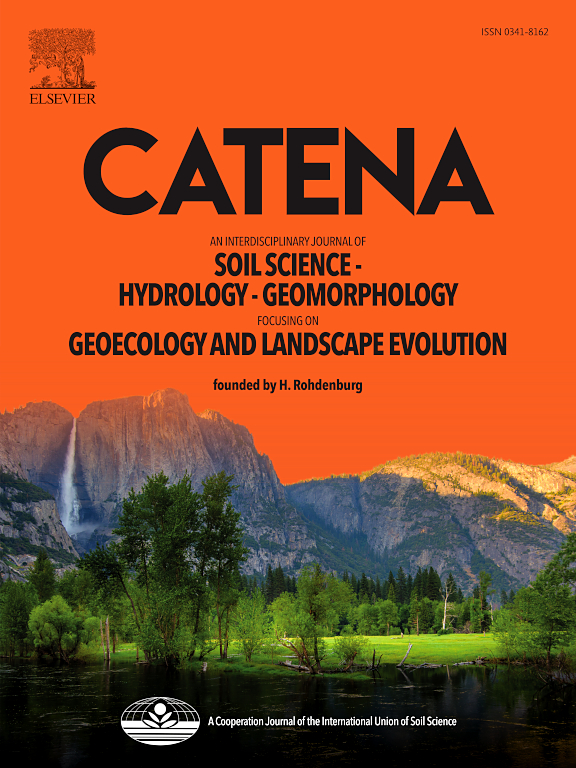白垩纪生物土壤结皮:古代旱地微生物生活和土壤发育的一瞥
IF 5.7
1区 农林科学
Q1 GEOSCIENCES, MULTIDISCIPLINARY
引用次数: 0
摘要
生物土壤结皮是在现代极端环境下具有重要生态作用的生物沉积结构。随着微生物群落在水文压力和侵蚀的干扰环境中蓬勃发展,它们既是生态系统工程师,也是裸露土壤的先驱殖民者,特别是在干旱和极地地区。尽管BSCs在土壤发育和生态演替中具有重要意义,并且在当代环境中广泛存在,但它们在古土壤学记录中的代表性明显不足。本文对巴西Bauru盆地Marília组古土壤中保存的白垩系生物土壤结皮进行了宏观和微观形态分析,阐明了其生物成因及其古环境意义。所研究的地壳呈现出特有的微生物沉积结构,包括褶皱痕迹、气丘、门扇孔隙和干燥裂缝,以及保存完好的球茎状微生物细丝、细胞外聚合物(EPS)和碳酸盐球粒。这些特征与现代半足类动物非常相似,特别是以有机(CruO)和有机-矿物(CruOA) AC层为特征的壳-腐殖质系统。这些结构反映了土壤发育过程中有机质积累和生物活性的增强,进一步支持了它们作为蓝藻主导的微生物垫(BSCs)稳定洪泛平原的解释。显微形态学和扫描电镜分析证实了生物风化特征、钙化根细胞和微生物诱导的CaCO3沉淀,增强了它们的生物原性。BSCs与根石和无脊椎动物痕迹化石的关联表明了沉积沉积后景观稳定和早期生态演替的时期。古环境重建指向季节性半干旱条件,间断性洪水事件打断,BSCs在地面暴露间隔期间发育。该研究强调了BSCs在解释古土壤和沉积动力学方面的重要性,为白垩纪陆地生态系统提供了新的见解。本文章由计算机程序翻译,如有差异,请以英文原文为准。
Cretaceous biological soil crusts: a glimpse of ancient dryland microbial life and soil development
Biological soil crusts (BSCs) are bio-sedimentary structures that play vital ecological roles in modern extreme environments. As microbial communities thriving in disturbed settings under hydrological stress and erosion, they function as both ecosystem engineers and pioneer colonizers of bare soils, particularly in arid and polar regions. Despite their significance for soil development and ecological succession and their widespread occurrence in contemporary environments, BSCs remain markedly underrepresented in paleopedological records. This study presents a detailed macro and micromorphological analysis of Cretaceous biological soil crusts preserved in paleosols of Marília Formation (Bauru Basin, Brazil), elucidating their biogenic origin and paleoenvironmental significance. The studied crusts exhibit characteristic microbial sedimentary structures, including wrinkle marks, gas domes, fenestral porosity, and desiccation cracks, alongside well-preserved coccoid microbial filaments, extracellular polymeric substances (EPS), and carbonate spherulites. These features closely resemble modern humipedons, particularly crusto-humus systems characterized by organic (CruO) and organo-mineral (CruOA) AC horizons. Such structures reflect enhanced organic matter accumulation and biological activity during soil development, further supporting their interpretation as cyanobacteria-dominated microbial mats (BSCs) that stabilized floodplain. Micromorphological and SEM analyses confirm bioweathering signatures, calcified root cells, and microbial-induced CaCO3 precipitation, reinforcing their biogenicity. The association of BSCs with rhizoliths and invertebrate trace fossils indicates periods of landscape stability and incipient ecological succession following sedimentary deposition. Paleoenvironmental reconstruction points to seasonally semi-arid conditions punctuated by intermittent flooding events, with BSCs developing during intervals of subaerial exposure. This study underscores the significance of BSCs for interpreting paleosols and sedimentation dynamics, providing new insights into Cretaceous terrestrial ecosystems.
求助全文
通过发布文献求助,成功后即可免费获取论文全文。
去求助
来源期刊

Catena
环境科学-地球科学综合
CiteScore
10.50
自引率
9.70%
发文量
816
审稿时长
54 days
期刊介绍:
Catena publishes papers describing original field and laboratory investigations and reviews on geoecology and landscape evolution with emphasis on interdisciplinary aspects of soil science, hydrology and geomorphology. It aims to disseminate new knowledge and foster better understanding of the physical environment, of evolutionary sequences that have resulted in past and current landscapes, and of the natural processes that are likely to determine the fate of our terrestrial environment.
Papers within any one of the above topics are welcome provided they are of sufficiently wide interest and relevance.
 求助内容:
求助内容: 应助结果提醒方式:
应助结果提醒方式:


